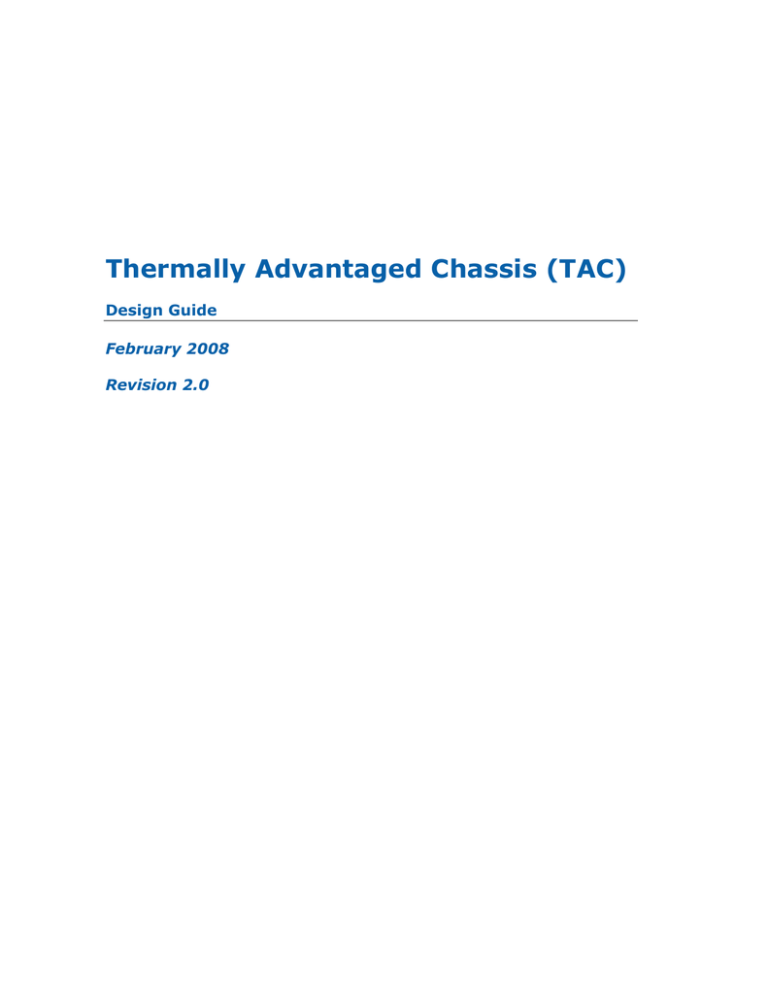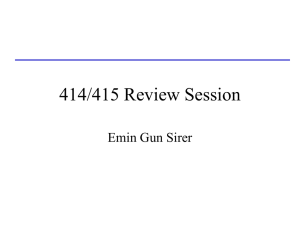
Thermally Advantaged Chassis (TAC)
Design Guide
February 2008
Revision 2.0
INFORMATION IN THIS DOCUMENT IS PROVIDED IN CONNECTION WITH INTEL® PRODUCTS. NO
LICENSE, EXPRESS OR IMPLIED, BY ESTOPPEL OR OTHERWISE, TO ANY INTELLECTUAL PROPERTY
RIGHTS IS GRANTED BY THIS DOCUMENT. EXCEPT AS PROVIDED IN INTEL'S TERMS AND
CONDITIONS OF SALE FOR SUCH PRODUCTS, INTEL ASSUMES NO LIABILITY WHATSOEVER, AND
INTEL DISCLAIMS ANY EXPRESS OR IMPLIED WARRANTY, RELATING TO SALE AND/OR USE OF
INTEL PRODUCTS INCLUDING LIABILITY OR WARRANTIES RELATING TO FITNESS FOR A
PARTICULAR PURPOSE, MERCHANTABILITY, OR INFRINGEMENT OF ANY PATENT, COPYRIGHT OR
OTHER INTELLECTUAL PROPERTY RIGHT.
UNLESS OTHERWISE AGREED IN WRITING BY INTEL, THE INTEL PRODUCTS ARE NOT DESIGNED
NOR INTENDED FOR ANY APPLICATION IN WHICH THE FAILURE OF THE INTEL PRODUCT COULD
CREATE A SITUATION WHERE PERSONAL INJURY OR DEATH MAY OCCUR.
Intel may make changes to specifications and product descriptions at any time, without notice.
Designers must not rely on the absence or characteristics of any features or instructions marked
"reserved" or "undefined." Intel reserves these for future definition and shall have no responsibility
whatsoever for conflicts or incompatibilities arising from future changes to them. The information
here is subject to change without notice. Do not finalize a design with this information.
The Intel logo is a trademark of Intel Corporation in the U.S. and other countries.
Copyright © 2008, Intel Corporation. All rights reserved.
Contents
1
Introduction .....................................................................................................5
1.1
1.2
1.3
1.4
2
Section 2 .........................................................................................................7
2.1
2.2
2.3
2.4
3
Shock Test ..........................................................................................11
Vibration Test ......................................................................................11
Pass Criteria ........................................................................................11
Regulatory Considerations................................................................................12
4.1
4.2
4.3
5
Thermally Advantaged Chassis Description.................................................7
Thermally Advantaged Chassis Typical Airflow Pattern .................................8
System Fans..........................................................................................9
TAC 2.0 Vent Size and Location ..............................................................10
Dynamics ......................................................................................................11
3.1
3.2
3.3
4
Scope ...................................................................................................5
Overview ..............................................................................................5
Recommended Chassis Type ....................................................................6
Reference Documents .............................................................................6
Electromagnetic Interference Radiation....................................................12
Safety ................................................................................................13
Ecology...............................................................................................13
Mechanical Drawings .......................................................................................14
Figures
Figure 1. Typical Tower Platform With Optimized Side Vent .....................................7
Figure 2. Thermally Advantaged Chassis Typical Airflow Pattern...............................8
E34579 / TAC 2.0 Design Guide
3
Revision History
Revision
Number
Description
Revision Date
1.0
Initial release. Chassis Air Guide (CAG) Design Guide
May 2002
1.1
System vent pattern optimization. Chassis Air Guide (CAG)
Design Guide
September 2003
2.0
Re-design to accommodate 2009 platforms. Document title
renamed to Thermally Advantaged Chassis (TAC) 2.0 to
reflect the elimination of the CAG side duct.
February 2008
Introduction
1
Introduction
1.1
Scope
This design guide explores the design and performance of a generic airflow
management scheme to adequately cool the internal components of a personal
computer. Design recommendations are presented for implementation within midtower and mini-tower desktop style enclosures. The target audiences for this
document are: computer enclosure engineers, designers, and system integrators.
1.2
Overview
In order to facilitate next generation PC platform designs for 2009 and beyond, it has
become necessary to alter the physical location of the processor relative to previous
platform generations. Earlier versions of the Chassis Air Guide (CAG) Design Guide
presented a reference airflow management scheme that was dependant on a relatively
consistent location of the processor. The TAC 2.0 design guide accommodates this
change in processor location and provides backward compatibility to previous PC
platform generations.
Improvements in processor architecture design and reductions in transistor leakage
have resulted in more efficient processors that consume less power with better
performance than earlier generations. The goal of previous CAG Design Guide versions
was to define a means to limit the processor inlet temperature to a maximum of 38 °C
to allow for the use of cost effective processor cooling devices. With the improvements
in latest generation processor designs and performance it is possible to design cost
effective processor cooling solutions with a higher inlet temperature. Therefore, In
addition to eliminating processor location dependency, the TAC 2.0 Design Guide also
defines a new processor cooling solution inlet temperature target of 40 °C.
The scope of the previous CAG Design Guide was centered on an enclosure side duct
that delivered cooler external air directly to the processor fan heatsink. This revised
design guide eliminates the duct and relies solely on optimized chassis venting and
airflow management. This not only eliminates the above mentioned processor location
dependency but also allows for PC enclosure cost reduction when compared to
previous CAG Design Guide versions.
Proper thermal management of PC enclosure design is critical to the performance and
functionality of internal PC components as well as achieving desirable acoustic noise
levels. There are many different ways to provide proper chassis thermal management.
The design approach described in the document is one such method that if
implemented correctly will provide a single, cost effective solution for a wide range of
PC platform generations.
E34579 / TAC 2.0 Design Guide
5
1.3
Recommended Chassis Type
This design guide refers to a chassis with the features listed below. However, the
ingredients and design techniques described here could be adapted to other chassis:
-
Fits a standard ATX or μATX motherboard
-
Supports two external 5.25-inch peripheral bays, one or two external 3.5-inch
peripheral bays, and one or two internal 3.5-inch peripheral bays
-
Includes standard support for add-in cards
-
Provides single system-fan cooling with provision for at least one 92mm rear
exhaust fan
o
-
1.4
(Note that this statement excludes the fan in the Power Supply)
Internal power supply with fan exhausting from the system enclosure
Reference Documents
Document / Resource
Document Location
ISO 7779-Acoustics–Measurement of Airborne Noise Emitted by
information Technology and Telecommunications Equipment
http://www.iso.org
General system and component design guides and suggestions
http://www.formfactors.org/
Section 2
2
Section 2
2.1
Thermally Advantaged Chassis Description
The following design is intended to provide a desirable internal thermal environment
for standard ATX and μATX tower style chassis. One key goal is to achieve a
temperature rise from external ambient to the processor fan heatsink (Trise) of 5 °C or
less (or 40°C inlet to the fan heatsink at the typical maximum external ambient
temperature of 35°C). Details on thermocouple placement for CPU fan heatsink inlet
temperature measurement can be found in applicable Thermal Design Guide (TDG)
documents. This design does not require any special ducting or other components
typically not found in PC enclosure designs and relies entirely on vent size/placement
and proper air flow.
Figure 1 represents a generic μATX tower chassis similar to that used in many
platforms currently available. The single side vent shown has been optimized in size,
location, and effective open area to provide desirable internal temperature conditions
at external operating temperatures of 35 °C or less. The vent relies entirely on typical
internal system fans (one rear chassis exhaust fan, one power supply exhaust fan,
and one active CPU heatsink fan) to distribute air throughout the system components.
There is no requirement for a side panel intake fan with this design approach. Detailed
size and location dimensions for the side vent are shown in Section 5.
Figure 1. Typical Tower Platform With Optimized Side Vent
E34579 / TAC 2.0 Design Guide
7
2.2
Thermally Advantaged Chassis Typical Airflow
Pattern
Figure 2 depicts the intended airflow pattern with the side vent. This system has a
92mm rear system fan and 80mm power supply fan. Both fans exhaust (blow out)
from the chassis, thereby providing intake airflow for internal system component
cooling. This fan configuration causes depressurization of the chassis interior with
respect to the outside air. As a result, all other chassis openings become intake vents.
The primary intake vent defined in this design guide is the side panel vent however
other smaller vent locations such as the front bezel and add-in card areas can be
beneficial as well.
Airflow balancing is critical to ensure the adequate cooling of all system components.
Without proper balancing, some components may operate cooler than required while
others may operate in a higher temperature environment. Proper airflow balancing is
difficult to manage but done properly, should allow all system components to operate
within the recommended temperature range. Ensuring balanced airflow is the
responsibility of the chassis designer.
Figure 2. Thermally Advantaged Chassis Typical Airflow Pattern
Section 2
2.3
System Fans
Rear Chassis System Exhaust Fan:
The chassis mounted system fan remains a critical part of the overall system solution.
The rear exhausting system fan contributes to the intended low internal pressure that
forces cooler external air to flow into the system vent(s). A 92mm rear fan is
recommended however there are many options that will perform adequately. It is
critical to design the vent opening for the rear chassis fan to minimize back pressure
so that it does not overly restrict the exhaust air flow. The chassis designer is
responsible for selecting the appropriate rear exhaust fan and corresponding vent
design for a given application.
Power Supply Fan:
The power supply fans seen in the market today in general have shown to be
adequate to support the overall system air flow design intent defined in this
document. The power supply fan must exhaust the internal chassis air outside of the
system to assist with internal cooling. A power supply fan that pressurizes the chassis
could render the TAC 2.0 vent configuration ineffective. No changes or special
considerations beyond air flow direction are intended for power supplies in this design
guide.
Note: Some enclosure designs may utilize system pressurizing via intake fans for
thermal management. This is a design choice that is not intended or recommended in
the scope of the TAC 2.0 Design Guide.
Processor Active Fan Heat Sink:
Much the same as the rear system and power supply exhaust fans, the processor
cooling fan remains a critical piece of the overall system cooling solution. An active
CPU fan heatsink with airflow directed towards the main board is assumed in the TAC
2.0 Design Guide and is needed to properly cool the processor and surrounding
components.
Optimized chassis airflow will directly minimize the performance requirements (and
cost) of internal heat dissipation devices such as processor fan heatsinks.
E34579 / TAC 2.0 Design Guide
9
2.4
TAC 2.0 Vent Size and Location
The TAC 2.0 Design Guide requires a side vent as seen in Figure 1. This vent
configuration has been optimized by means of thermal modeling and system level
testing. The size of this vent is recommended to be 110mm wide and 150mm tall. The
TAC 2.0 side vent is best located with respect to the standard ATX mounting holes as
defined in the ATX Specification. Refer to Section 5 for detailed vent size and location
dimensions.
It is recommended that this vent have an effective open area of at least 60%. This will
maximize the effectiveness of the vent and should still contain EMI effectively. Lower
open area percentages may also be effective however this is a design choice and
understanding the performance implications for a given chassis is the responsibility of
the chassis designer. Proper EMI containment is also the responsibility of the chassis
manufacturer.
Venting in the front of the chassis behind the bezel is an important component of
overall system airflow. However, due to wide ranging variations in bezel
configurations, front vent design details must be left to the chassis designer.
The chassis designer may want to provide features on the chassis side panel to
mitigate vent blocking if the system should be placed against a wall, desk or other
obstruction.
Dynamics
3
Dynamics
While this design guide requires no additional discrete chassis components it is
recommended that the chassis be able to withstand the dynamic stress conditions
listed below without displaced or damaged components.
3.1
Shock Test
Unpackaged
25 g, 11 ms trapezoidal; ~ 170 in/s
Two drops in each of the six directions applied to each of the test samples
3.2
Vibration Test
Unpackaged
Sine sweep: 5 Hz to 500 Hz @ 0.5 g ±10%; @ 0.5 octaves/min; Dwell 15 min at
each of three resonant points
Random Profile: 5 Hz @ 0.01 g2 /Hz to 20 Hz @0.02 g2/Hz (slope up)
20 Hz to 500 Hz @ 0.02 g2/Hz (flat)
Input acceleration: 3.13 g RMS
10 min/axis for all axes on all samples
Random control limit tolerance is ±3 dB
3.3
Pass Criteria
•
No visible or functional damage.
•
No displaced or dislodged components.
E34579 / TAC 2.0 Design Guide
11
4
Regulatory Considerations
The PC must meet a number of regulatory Safety, EMC and Ecology concerns. Specific
requirements for Information Technology Equipment vary somewhat by country,
however, the overall standards are somewhat unified and are based upon the
following standards: Note: Certain countries may require formal certifications and
many require a Declaration of Conformance (DOC) be placed in the manual or on the
box. In Europe the CE mark and a DOC is required for every computing device.
4.1
Electromagnetic Interference Radiation
The Electromagnetic Interference (EMI) performance of a system is determined by the
degree of noise suppression designed into the system motherboard and the provisions
for EMI containment in the chassis design, including placement of internal subsystems
and cables. Requirements call for compliance to stringent electromagnetic
compatibility (EMC) limits such as the CISPR-22 European standard or the FCC “B”
United States standard. Open chassis requirements for board manufacturers suggest
that most EMI needs to be suppressed at the board level. The chassis, however,
should provide at least 6 dB of EMI attenuation or Shielding Effectiveness (SE)
throughout the spectrum. The goal of 6 dB assumes the board complies with FCC Part
15 (Open Box Test). Boards that have higher expected emissions will likely require
additional containment. These standards, along with higher processor and video
frequencies, call for additional chassis containment provisions. Basic design principles
have not changed, but as frequencies increase, the shorter wavelengths require more
frequent ground contacts and smaller apertures in the chassis design.
EMC Standards:
•
47 CFR Parts 2 and 15 (USA)
•
ICES-003 (Canada)
•
EN55022:1998 (European Union Emissions)
•
EN55024:1998 (European Union Immunity)
•
Other International requirements based upon CISPR 22
Regulatory Considerations
4.2
Safety
This design guide is not intended to cover all safety aspects that may pertain to
different countries and regulatory bodies. The safety standards listed below are a
starting point for reference however, the manufacturer is ultimately responsible to
ensure that all applicable safety standards are adhered to.
Safety Standards:
4.3
•
IEC 60590 (International)
•
UL/CSA 60950 (USA and Canada)
•
EN60590 (European Union)
Ecology
This design guide is not intended to cover every aspect of designing a product to meet
every International regulation, however, the following standards and programs may
cover Ecology issues that may or may not apply to your product.
Ecological Standards
•
ECMA TR70:
•
Energy Star
•
TCO '99, Blue Angel
•
RoHS
Ecological Programs
•
Participation in waste electronics recycling program.
•
Participation in a packaging-recycling program.
E34579 / TAC 2.0 Design Guide
13
5
Mechanical Drawings



